If you are reading these rules for the first time, ignore the text along the right hand side. These rules serve as a summary to help you quickly familiarize yourself with the game.
Show
→ summary only
→ detailed version only
→ both summary and detailed version

Cacao
→ Original rules (pdf)
→ Overview jungle tiles (pdf)
→ Goodie Volcanoes (pdf)
→ Goodie Big Market (pdf)
→ Goodie Golden Temple (pdf)
→ Goodie New Storage (pdf)
→ Goodie New Huts (pdf)
Cacao takes the players into the exotic world of the “Fruit of the Gods.” Each is a tribal chief trying to lead their tribe to fame and
wealth by growing and trading in cacao. At the end of the game, the player with the most gold wins.
Cacao – Chocolatl
contains 4 expansion modules that can be integrated into the basic game of Cacao, individually or in any
combination:
the Map module, the Watering module,
the Chocolate module and the Hut module.
→ Chocolatl original rules (pdf)
Cacao – Diamante
contains 4 expansion modules that can be integrated into the basic game of Cacao, individually or in any
combination:
the Gem Mines, the Tree of Life,
the Favor of the Emperor and the New Workers.
In addition, the new modules can be combined with the modules from Cacao – Chocolatl in any way you desire.
→ Diamante original rules (pdf)
Game materials
44
worker tiles, 11 each in the 4 player colors
4
water carriers, 1 each in the 4 player colors
4
village boards, 1 each in the 4 player colors
28
20
cacao fruits
12
sun tokens
48
gold coins, 24x value 1, 12x value 5, 12x value 1
1
set of instructions
1
overview sheet for jungle tiles
Each player puts the water carrier on the water field with the value “-10”, shuffles their worker tiles and
lays them out as a face-down jungle draw pile. After that, they draw the 3 top worker tiles.
Note:With 3 and 4 players some worker tiles are sorted out.
A single plantation and a market with selling price 2 are placed face up in the middle of the table diagonally to one another.
Mix the remaining jungle tiles and place them as a face-down jungle draw pile. Draw the 2 top jungle tiles and place them as a face-up jungle display.
Note: With 2 players some jungle tiles are sorted out.
Each player chooses one color. They take the village board, the water carrier and the worker tiles of that color.
They place the village board in front of them and put the water carrier on the water field with the value “-10”.
Worker tiles
The worker tiles show a sand-colored area with a hut in the respective player color in the middle.
There are always 4 workers of this color depicted at the edges of the tile in various distributions.
Depending on the number of players, each player sorts out the following worker tiles and puts them back in the box:
3 players: 1x 1-1-1-1
4 players: 1x 1-1-1-1 and 1x 1-2-1-0
Mix your worker tiles and put them as a face-down worker draw pile next to your village board. After that, you draw the
3 top worker tiles from your worker draw pile and take them into your hand.
Jungle tiles
The jungle tiles are predominantly green and show locations with different action possibilities that you can use if there are
workers adjacent.
Select the following 2 jungle tiles and place them face up in the
middle of the table diagonally to one another; they form the starting tiles of the playing area:
1x single plantation and 1x market with selling price 2
For the two-player game only, sort out the
following jungle tiles and put them back in the box:
2x single plantation, 1x market, selling price 3, 1x gold mine, value 1, 1x water, 1x sun-worshiping site, 1x temple
Mix the remaining jungle tiles and lay them out as a face-down jungle draw pile.
Draw the 2 top jungle tiles from the jungle draw pile and place them next to the pile as a face-up jungle display.
Then lay out the cacao fruits and the sun tokens as separate supply piles. Put the gold coins next to them to serve as the bank.
Course of the game
The game proceeds over several rounds, played in clockwise order. The oldest player becomes the starting player and begins.
The playing area
During the course of the game, the players add worker tiles and jungle tiles to the playing area.
These tiles must alternate, forming a chessboard pattern of worker and jungle tiles.
During the course of the game, the players add worker tiles and jungle tiles to the playing area.
In general, the following tile-laying rules apply:
- A worker tile may never be laterally adjacent to other worker tiles.
- A jungle tile may never be laterally adjacent to other jungle tiles.
This way, a chessboard pattern of worker and jungle tiles is formed. The starting tiles have
already determined whether you have to put a worker tile or a jungle tile on an unoccupied
square of this pattern. In the following, the squares that are occupied with jungle tiles are
called jungle spaces.
A game turn
On your turn, you have to carry out the following steps in the order indicated:
-
Place 1 worker tile adjacent to at least 1 jungle tile already in play or build over a worker tile of your own.
-
Fill in jungle tiles.
-
Carry out jungle tile actions for the newly placed worker tile
and eventually filled in jungle tiles.
On your turn, you have to carry out the following steps in the order indicated:
-
Place 1 worker tile
Choose 1 worker tile from your hand and place it laterally adjacent to at least 1 jungle tile already in play.
You may orient the worker tile in any direction you want.
Towards the end of the game, you can use sun tokens to “overbuild”
one of your own worker tiles.
-
Fill jungle spaces
The placement of worker tiles can trigger the filling of jungle spaces. If, due to the newly placed worker tile, there are now
2 worker tiles adjacent to 1 unoccupied jungle space, you have to fill this space. It doesn’t matter to whom the adjacent
worker tiles belong. It may happen that several jungle spaces need to be filled.
For each jungle space to be filled, you pick 1 jungle tile from
the jungle display and place it on the applicable space. If you
have to fill 2 jungle spaces, you can decide which jungle tile
you put on which of the two spaces.
Attention: The jungle display is refilled only at the end of the game turn.
Note: In the extremely unlikely case that you have to fill
more than 2 jungle spaces, you first place the two tiles
from the jungle display. In order to fill more jungle
spaces, you draw the jungle tiles from the jungle draw
pile.
If you don’t have to fill a jungle space resulting from the newly placed worker tile, or if
there are no jungle tiles left in the jungle display and in the jungle draw pile, the filling
action is omitted.
-
Carry out jungle tile actions
Each worker on the newly placed worker tile that is adjacent to a jungle tile is
activated. By activating a worker, you may carry out the actions of the adjacent
jungle tile. You find a detailed description of the actions of the different jungle tiles on
the overview sheet for jungle tiles
If jungle spaces have been filled during the current turn, now the adjacent workers
of the respective other players are activated as well.
Attention: Each worker is activated exactly one time during the game –
either by placing the worker tile or by filling adjacent jungle spaces with
jungle tiles later on.
Note: Everybody involved may partly or entirely forgo the carrying out of actions.
You may freely determine the order in which you carry out the actions. However,
the actions for workers on one edge of the tile have to be completed before the
actions for workers on another edge of the tile are carried out.
Ending a turn
After steps 1. through 3. have been carried out, you draw the top worker tile from your worker draw pile and take it into your
hand. If your worker draw pile has been depleted, you skip this action.
If there are less than 2 jungle tiles in the jungle display, it is refilled to 2 jungle tiles by drawing tiles from the jungle draw pile,
as far as possible. If the jungle draw pile has been depleted, the refilling of the jungle display is skipped.
This ends your turn; now it is your left neighbor’s turn.
End of the game
The game ends after the round in which all players have placed their last worker tile.
Scoring
-
The temples are scored individually, one after another. The players in first and second place obtain gold,
see overview.
-
For each sun token that you still own at the end of the game, you get 1 gold from the bank.
-
Finally, you add up your gold and add to it the value of the water field on which your water carrier
is standing at the end of the game. If the water carrier is still standing on a field with a negative value, you have to deduct the applicable number.
Note: Left-over cacao fruits don’t give you any gold.
The player with the most gold wins.
In case of a tie, the player who wins is the one who has the most cacao fruits left. If there is still a tie, the players involved
share the win.
Appendix
The jungle tiles
Plantation
Single plantation
For each of your activated workers on the adjacent edge of the tile,
you may take 1 cacao fruit from the supply.
Double plantation
For each of your activated workers on the adjacent edge of the tile,
you may take 2 cacao fruits from the supply.
You put them individually
on 1 unoccupied storage space on your village board. Each player has
5 storage spaces and may never store more than 5 cacao fruits; any
additional fruits that you acquire go to waste.
Market
Selling price 2
For each of your activated workers on the adjacent edge of the tile,
you may sell 1 cacao fruit from your storage for 2 gold.
Selling price 3
For each of your activated workers on the adjacent edge of the tile,
you may sell 1 cacao fruit from your storage for 3 gold.
Selling price 4
For each of your activated workers on the adjacent edge of the tile,
you may sell 1 cacao fruit from your storage for 4 gold.
You put the cacao fruit back in the supply and then take
the corresponding gold from the bank.
Goldmine
Value 1
For each of your activated workers on the adjacent edge of the tile,
you may take 1 gold from the bank.
Value 2
For each of your activated workers on the adjacent edge of the tile,
you may take 2 gold from the bank.
Water
For each of your activated workers on the adjacent edge of the tile,
you may move the water carrier on your village board 1 water field
ahead in a clockwise direction. If the water carrier reaches the water
field with the value “16,” they stop there; any possible further steps go
to waste.
At the end of the game, you add to your gold coins the value of the
water field on which your water carrier is standing. If the water carrier
is still standing on a field with a negative value, you have to deduct the
applicable number.
Sun-worshiping Site
For each of your activated workers on the adjacent edge of the
tile, you may take 1 sun token from the supply. You put it on an
unoccupied sun-worshiping place on your village board. Each player
has 3 sun-worshiping places and may never own more than 3 sun
tokens. Sun tokens that you might get beyond that go to waste.
Towards the end of the game, you can use sun tokens to “overbuild”
one of your own worker tiles. At the end of the game, you get 1 gold
from the bank for each sun token you have not used.
Overbuild
When the jungle draw pile has been depleted towards the end of the game and there are no jungle tiles left in the jungle
display, you may, from now on, overbuild one of your
own
worker tiles, instead of adding it to the playing area in the usual
way; for this, you have to put 1 sun token back in the supply. Choose 1 worker tile from your hand and put it
on top of
oneof your
own
worker tiles that you placed earlier. After that, you carry out the actions of the adjacent jungle tiles for the
activated workers. If you don’t own any sun token, you cannot overbuild and have to place the new worker tile as usual.
Important: Each worker tile may be overbuilt only once.
Temple
The temples have no direct effect during the game. Only at the end of the game are the temples scored,
individually, one after another. The player who has the most workers adjacent to the respective temple
receives 6 gold from the bank. The player with the second most adjacent workers obtains 3 gold.
If there is a tie for first place, 6 gold are evenly distributed among the players involved (and rounded down, if
necessary). In this case, there is no gold awarded for second place.
In case first place is clear but there is a tie for second place, 3 gold are evenly distributed among the players
involved (and rounded down, if necessary).
Attention: If any worker tiles adjacent to the temple have been overbuilt, only the worker tile on top counts for the
scoring.
Note: If there is only 1 player with workers adjacent to the temple, they get 6 gold from the bank, as usual; no gold is
awarded for second place. You need to have at least 1 worker adjacent to the temple in order to score for it.
Goodie Volcanoes
Set-up: First replace the 3 gold mines with the 3 volcano tiles. Put the gold mines back in the box.
For the two-player game only, sort out 1 volcano instead of 1 gold mine with value 1 and put it back
in the box.
Action:
For each of your activated workers, depending on the value indicated on the adjacent edge
of the tile, you must take 2 gold from the bank or pay 1 gold to the bank. If you have no gold coins at
that moment, you do not have to pay.
Goodie Big Market
All rules of the base game apply, with the following changes:
Set-up:
First put 1 jungle tile "market" with the selling price 3 back in the box. Then, mix the "big market" with the remaining jungle tiles
and lay them out as a face-down jungle draw pile.
Action:
For each of your activated workers on the adjacent edge of the tile, you may sell 1 cacao fruit from your storage at the price of 5 gold on the market.
Goodie Golden Temple
All rules of the base game apply, with the following changes:
Set-up:
First put 1 jungle tile "temple" back in the box. Then, mix the "golden temple" with the remaining jungle tiles
and lay them out as a face-down jungle draw pile.
Action:
The "golden temple" is scored with the other temples at the end of the game. The player in first place at "the golden temple" receives 8 gold,
the player in second place receives 1 gold. Other than that, the usual rules for the temple scoring apply.
Goodie New Storage Spaces
The usual rules for playing with the huts module apply:
The "New Storage Spaces" count as huts. They are placed
as a supply near the bank together with the other huts as
described in the Cacao – Chocolatl rules.
Building costs: 6 Gold
Function:
You have 3 additional storage places during the
game. Now you can store up to 8 cacao fruits
total.
Goodie New Huts
The "New Huts" count as huts. They are placed as a supply near the bank
together with the other huts as described in the "Cacao – Chocolatl" rules.
Depending on the huts in play, you have to play with the Map and/or Chocolate
module.
Yucata special: if playing without option 'force modules', huts where the corresponding module is not selected will be skipped.
The usual rules for playing with the huts module apply.
Chocolate Maker
Building costs: 7 Gold
Function:
Throughout the game, you sell your chocolate
bars at chocolate markets for 8 gold instead of
for 7.
Scout
Building costs: 9 Gold
Function:
In order to pick jungle tiles from the map board
during the game, you don’t have to give up a map
tile.
RainMaker
Building costs: 13 Gold
Function:
You immediately place your own water carrier
on the water field with the value “0”. It stays
there until the end of the game and cannot be
moved forward. When playing with the Watering
module, you don’t have to move your water
carrier back to take 4 cacao fruits for an activated
worker adjacent to a watering tile.
Game material
1
map board
8
map tiles, 2 for each player
Each player gets 2 map tiles.
2 extra tiles are drawn from the jungle draw pile and placed face up on the marked spaces of the map board.
Each player gets 2 map tiles. The surplus map tiles are put back into the box.
After setting out the jungle draw pile, place the map board directly next to it. Then, instead of drawing only the top 2 jungle
tiles from the draw pile, draw the top 4 tiles. Lay the first two tiles face up on the marked spaces of the map board. Place the
other two tiles, as usual, as a face-up jungle display next to the map board.
Course of the game
If you have to refill jungle spaces, you can – as usual – choose from the two tiles of the jungle display. In order to pick 1 jungle
tile from the map board instead of from the display, you have to give up 1 map tile and put it back into the box.
Note: You are allowed to use your two map tiles on the same turn.
The map board is refilled only at the end of the game turn. Before drawing new jungle tiles, you first need to move tiles from
the map board to the jungle display, so that there are 2 tiles lying there again.
Attention: Unused map tiles don’t give you any gold at the end of the game.
Remove 1 single plantation and 2 double plantations and replace them with the
3 watering tiles.
Attention: For the two-player game, replace only the two double plantations with 2 watering tiles.
Instead of the market with a selling price of 2, select 1 water tile
as the second starting tile.
At the beginning of the game set-up, remove 1 single plantation and 2 double plantations and replace them with the
3 watering tiles. Put the removed tiles back into the box.
Attention: For the two-player game, replace only the two double plantations with 2 watering tiles. Put the third watering tile
back into the box.
Instead of the market with a selling price of 2, select 1 water tile
as the second starting tile.
Course of the game
For each activated worker you may move the water carrier back 1 water field. For each water field that you move your water carrier back, you get 4 cacao
fruits.
If your water carrier is standing on the water field with the value “-10”, you can’t get any fruit.
Attention: Any additional cacao fruit that you would get goes to waste, as usual.
For each of your activated workers on the adjacent edge of the tile, you may move the water carrier on your village
board back 1 water field in an anti-clockwise direction. For each water field that you move your water carrier back, you take 4 cacao
fruits from the supply and put them on unoccupied storage spaces on your village board.
If your water carrier is standing on the water field with the value “-10”, you can’t get any fruit.
Attention: Any additional cacao fruit that you would get goes to waste, as usual. Therefore, it doesn’t make sense to connect
tile edges that have more than 1 worker to a watering tile.
Game materials
3
jungle tiles: chocolate kitchen
3
jungle tiles: chocolate market
20
chocolate bars made of wood
Remove the 3 gold mines and 3 markets with a selling price of 3 and replace them with
the 3 chocolate kitchens and the 3 chocolate markets.
Attention: For the two-player game, replace only 1 gold mine with the value “2” and 1 gold mine with the value “1” with
2 chocolate kitchens. Additionally, replace only 2 markets with a selling price of 3 with 2 chocolate markets.
At the beginning of the game set-up, remove the 3 gold mines and 3 markets with a selling price of 3 and replace them with
the 3 chocolate kitchens and the 3 chocolate markets. Put the removed tiles back into the box.
Attention: For the two-player game, replace only 1 gold mine with the value “2” and 1 gold mine with the value “1” with
2 chocolate kitchens. Additionally, replace only 2 markets with a selling price of 3 with 2 chocolate markets. Put
the third chocolate kitchen and the third chocolate market back into the box.
Place the chocolate bars as a supply next to the cacao fruit.
Course of the game
Chocolate kitchen:
For each activated worker you may turn 1 cacao fruit from your storage into
1 chocolate bar. Put the chocolate bar from the supply on an unoccupied storage space on your village board.
Each storage space may be used either for 1 cacao fruit or for 1 chocolate bar.
Chocolate market:
For each activated worker, you may sell 1 cacao fruit from your storage for 3 gold, or
1 chocolate bar from your storage for 7 gold.
If you have activated more than 1 worker, you may choose for each whether you want
to sell 1 cacao fruit or 1 chocolate bar.
Attention: Leftover chocolate bars don’t give you any gold at the end of the game.
Chocolate kitchen:
For each of your activated workers on the adjacent edge of the tile, you may turn 1 cacao fruit from your storage into
1 chocolate bar. Put the cacao fruit back into the supply. After that, you take the chocolate bar from the supply and put it on
an unoccupied storage space on your village board.
Each storage space may be used either for 1 cacao fruit or for 1 chocolate bar.
Chocolate market:
For each of your activated workers on the adjacent edge of the tile, you may sell 1 cacao fruit from your storage for 3 gold, or
1 chocolate bar from your storage for 7 gold. Put the cacao fruit or the chocolate bar back into the supply and then take the
applicable amount of gold from the bank.
If you have activated more than 1 worker, you may choose for each of the activated workers individually whether you want
to sell 1 cacao fruit or 1 chocolate bar.
Attention: Leftover chocolate bars don’t give you any gold at the end of the game.
Game materials
12
hut tiles, printed on both sides, with differing functions on the front and on the back
Place the 12 hut tiles next to the bank with a randomly chosen side on top.
Take the 12 hut tiles into both hands and drop them from a low height onto the playing area. The sides that are now facing up
show the function of the huts. The backs don’t play a role for the current game.
After that, place the 12 hut tiles next to the bank as a supply, sorted by building costs.
Course of the game
At the end of your turn, you may build 1 hut, paying the building costs indicated at the top
of the hut.
For payment, you may use only gold coins that you already possess.
You may not build any hut with the same function twice – but you
may own any number of huts with different functions.
At the end of your turn, you may build 1 hut of your choice from the supply. You pay the building costs indicated at the top
of the hut by giving the applicable amount of gold to the bank.
For payment, you may use only gold coins that you already possess; gold that you would get at the end of the game (e.g., due
to your water carrier or for temples) cannot be used for this.
Place the huts you build next to your own village board. You may not build any hut with the same function twice – but you
may own any number of huts with different functions. Building a hut gives you either an advantage during the game or a
bonus in the end.
Game end
When scoring, you add the building costs for your huts to your gold, as well as a bonus some huts grant you.
The gold you paid for building the huts is not lost: When scoring, you add the building costs for your huts to your gold.
Besides this, some huts grant you a bonus that you add to your total score as well.
Overview huts
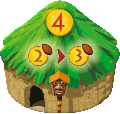
Market crier
Building costs: 4 gold
Function:
Throughout the game, you sell your cacao fruits at adjacent markets with
a selling price of 2 for 3 gold instead of for 2.
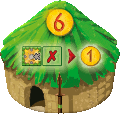
Hermit
Building costs: 6 gold
Function:
1 gold for each of your worker that doesn’t have an adjacent jungle tile at
the end of the game.
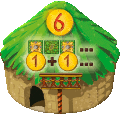
Road worker
Building costs: 6 gold
Function:
At the end of the game, you obtain 1 gold for each of your worker tiles in
the row or column where you have most of your worker tiles.
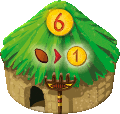
Trader
Building costs: 6 gold
Function:
Leftover cacao fruits in your own storage give you 1 gold each at the end
of the game.
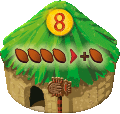
Farmer
Building costs: 8 gold
Function:
Whenever you get exactly 4 cacao fruits on one turn during the game, you
receive 1 more cacao fruit, provided you have enough space left in your
storage.
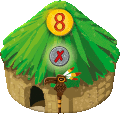
Shaman
Building costs: 8 gold
Function:
If you overbuild one of your worker tiles during the game, you don’t have
to put any sun token back into the supply for this.
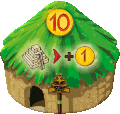
Monk
Building costs: 10 gold
Function:
1 gold at the end of the game for each temple you have at least 1 worker
adjacent to.
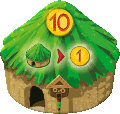
Master builder
Building costs: 10 gold
Function:
At the end of the game, you obtain 1 gold for each of your other huts.
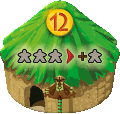
Foreman
Building costs: 12 gold
Function:
When you play a worker tile with 3 workers on one edge during the game,
it is counted as having an additional 4th worker on that edge.
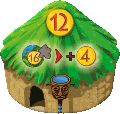
Fountain master
Building costs: 12 gold
Function:
4 gold at the end of the game if your own water carrier is standing on the
water field with the value “16”.
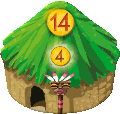
Chief’s daughter
Building costs: 14 gold
Function:
4 gold at the end of the game.
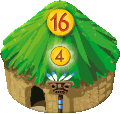
Chief’s son
Building costs: 16 gold
Function:
4 gold at the end of the game.
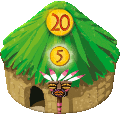
Chief’s wife
Building costs: 20 gold
Function:
5 gold at the end of the game.
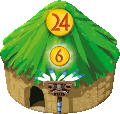
Chief
Building costs: 24 gold
Function:
6 gold at the end of the game.
Cacao – Diamante contains 4 expansion modules that can be integrated individually or in any
combination into the Cacao basic game. In addition, the new modules can be combined with the
modules from Cacao – Chocolatl in any way you desire. The “Big Game” variant makes it possible even
to play using all the modules of the two expansions and all elements of the basic game together. The
rules of the basic game apply, with the changes described as follows.
Game material
5
jungle tiles: gem mine
7
mask tiles, 2x each values 8, 9, 10 and 1x value 12
1
mine car
32
gems, 8x each in red, green, blue and white
Setup
5 temples are replaced by the 5 gem mines.
The 7 mask tiles are sorted by their values and laid out as a supply.
The 32 gems are mixed by shaking the mine car.
For the two-player game only 4 temples are replaced by 4 gem mines. The mask with
value 12 and 2 gems of each color are removed from the game.
At the beginning of the game set-up, remove the 5 temples and replace them with the 5 gem mines.
Put the removed tiles back into the box.
Sort the 7 mask tiles by their values and lay them out as a supply.
Fill the 32 gems into the mine car through the hole on the top and mix them by shaking the mine car.
Place the mine car next to the playing area.
For the two-player game, replace only 4 temples with 4 gem mines. The mask with the value 12 is
not needed. Additionally, remove 8 gems (2 of each color). Put the unused material back into the box.
Course of the game
As soon as a gem mine tile is revealed, 6 random gems are placed on it.
These stay on the tile when it is moved around.
Gem mine
For each of your activated workers on the adjacent edge of the tile, you may take 1 gem of your choice
from this gem mine. Place the gems next to your village board.
As soon as you have at least 1 gem in each of the 4 colors, you must immediately exchange this set
of 4 gems for the mask with the lowest value available from the supply.
Attention: If actions of at least one gem mine are carried out on a turn, the active player is the
first to carry out all his actions – also those of other tiles, if applicable. After that, the other
players follow in clockwise order.
As soon as a gem mine tile is placed in the jungle display (or on the map board if you play with the Map
Module from Cacao – Chocolatl), the active player takes the mine car and shakes out 6 gems through the
hole, one after another. Then they put these gems on the gem mine tile. When the gem mine tile is moved
on the map board or from there to the jungle display, or when it is placed on a space of the playing area,
the gems remain on the tile.
Attention: If you shake out more gems than needed, put the just fallen-out excess gems back into
the mine car.
Gem mine
For each of your activated workers on the adjacent edge of the tile, you may take 1 gem of your choice
from this gem mine. Place the gems next to your village board.
As soon as you have at least 1 gem in each of the 4 colors, you must immediately exchange this set
of 4 gems for the mask with the lowest value available from the supply. Remove the exchanged gems
from the game and put them back into the box.
Attention: If actions of at least one gem mine are carried out on a turn, the order of play
regarding the execution of the actions matters, as an exception. In this case, the active player is the
first to carry out all their actions – also those of other tiles, if applicable. After that, starting
with their left neighbor, the other players follow one after another in clockwise order.
End of the game
Add the values of your masks to your gold.
For each gem left next to your village board, you score 1 gold.
Add the values of your masks to your gold.
For each gem left next to your village board, you score 1 gold.
Game material
3
jungle tiles Tree of Life
Setup
3 gold mines are replaced by the 3 Trees of Life.
For the two-player game, replace only 1 value-2 gold mine and 1 value-1 gold mine with 2 Trees of
Life.
If you play with the Chocolate Module from Cacao – Chocolatl, you don’t remove any other jungle
tiles for the Trees of Life. Furthermore for a three-player game you remove no worker tile;
for the four-player game, each player removes only one 1-1-1-1 tile.
For the two-player game, only 2 Trees of Life are used. Additionally, each player takes their 0-0-0-4
worker tile from the New Workers Module.
At the beginning of the game set-up, remove the 3 gold mines and replace them with the 3 Trees of
Life. Put the removed tiles back into the box.
For the two-player game, replace only 1 value-2 gold mine and 1 value-1 gold mine with 2 Trees of
Life.
If you play with the Chocolate Module
from Cacao – Chocolatl, you don’t remove any other jungle
tiles for the Trees of Life. These new tiles are simply shuffled together with the other jungle tiles.
To maintain the balance between jungle tiles and worker tiles, you remove no worker tile for a
three-player game; for the four-player game, each player removes only one 1-1-1-1 tile.
For the two-player game, only 2 Trees of Life are used. Additionally, each player takes their 0-0-0-4
worker tile from the New Workers Module of this expansion
and shuffles it together with their worker tiles from the basic game.
Course of the game
Tree of Life:
For each of your activated workers on the adjacent edge of the tile, you may take 1 gold from the
bank.
If there are no workers depicted on the adjacent edge of the tile, you may instead take 3 gold from the bank.
Tree of Life:
For each of your activated workers on the adjacent edge of the tile, you may take 1 gold from the
bank.
But strength lies in serenity: If there are no workers depicted on the adjacent edge of the tile, you
may instead take 3 gold from the bank.
Setup
After laying out the starting tiles, place the Emperor on the market, selling price 2.
If you play with the Watering Module from Cacao – Chocolatl, the Emperor starts on the watering
tile instead.
After laying out the starting tiles, place the Emperor on the market, selling price 2.
If you play with the Watering Module
from Cacao – Chocolatl, the Emperor
starts on the watering tile instead.
Course of the game
Every time a player places a worker tile in the same row or column
where the Emperor is standing, the Emperor moves onto
the worker tile just placed, and the player obtains 1 gold.
If the Emperor is standing on a player's tile at the beginning of their turn, the
player obtains 1 gold.
Every time a player places one of their worker tiles somewhere in the row or column
of the playing area where the Emperor is standing, they move the Emperor onto
the worker tile they just placed (intermediate tiles and gaps are skipped). For this,
the player obtains 1 gold.
If the player begins their next turn with the Emperor still standing on their worker tile,
they get another 1 gold at the beginning of that turn, etc.
Game material
16
worker tiles with new worker distributions (backs in player colors)
4x each in red, purple, white and yellow
1x 0-0-2-2 / 1x 0-2-0-2 / 1x 0-1-0-3 / 1x 0-0-0-4 each
Setup
Before starting the game, players can agree on any combination of worker tiles from the basic game
and this module.
All players have to take the same tiles, and the number of tiles per player should
not be changed.
For longer game and more turns with the possibility of overbuilding worker tiles
also more worker tiles and possibly more jungle tiles can be used.
Depending on the number of players and the overbuilding options you might want,
we recommend the following ranges:
2 players: 1 to 8 more worker tiles than jungle tiles overall
3 players: 2 to 12 more worker tiles than jungle tiles overall
4 players: 3 to 16 more worker tiles than jungle tiles overall
All new worker tiles depict 4 workers at the edges in various distributions, as usual. However, the
distributions of these workers are different from those on the tiles in the basic game and thus bring
new possibilities into play.
Before starting the game, players can agree on any combination of worker tiles from the basic game
and this module. All players have to take the same tiles, and the number of tiles per player should
not be changed.
But if you want a longer game and more turns with the possibility of overbuilding worker tiles, you
can bring some more worker tiles per player into play.
This way, you can also bring modules with additional jungle tiles into play without exchanging them
for elements of the basic game. To maintain the balance between jungle tiles and worker tiles, you
should have more worker tiles than jungle tiles in play overall. Depending on the number of players
and the overbuilding options you might want, we recommend the following ranges:
2 players: 1 to 8 more worker tiles than jungle tiles overall
3 players: 2 to 12 more worker tiles than jungle tiles overall
4 players: 3 to 16 more worker tiles than jungle tiles overall
"Big Game" Variant (3 or 4 players only)
For a special playing experience, we recommend combining all the modules from Cacao – Chocolatl
and Cacao – Diamante with all the elements of the basic game to create one big game.
For the four-player game, all 60 worker tiles and all 45 jungle tiles are used.
For the three-player game, only 45 worker tiles are in play, so that the following jungle tiles need
to be removed:
2x single plantation; 2x gold mine, value 1; 1x market, selling price 2;
1x market, selling price 3; 1x watering
If possible, the jungle tile actions are carried out automatically. An exception here are the markets with
selling price 2 and 3 (and 4 if playing with the goodie "big market"), because a player might prefer to sell cacao at a market with a higher selling price.
If a player has both plantation and market actions to carry out, none of the actions will be carried out automatically
since the sequence of activation may be important.
If a player owns no cacao and has no plantation action to carry out, all market actions will automatically be performed without sale.
When carrying out a sale at a market with selling price 2 or 3 (or 4 if playing with the goodie "big market") a popup will open where the player may choose the number of
cacao fruits to sell at that market.
Other players' actions, which are not yet carried out, are marked with an asterisk.
For lack of space, a player's village board is generally not displayed. But you will find the values for the water
carrier (number of steps and the equivalent in gold), number of sun tokens and cacao fruits and gold at the player's overview.
The number in parentheses behind the number for the gold indicates the gold the player would have in case of an immediate end of game. Clicking on the numbers succeeding
the gold coin will open a popup with a breakdown of this virtual end score.
Clicking on the small disc with the blue 'i' on it in a player's overview opens a popup displaying that player's village board.
Clicking on a player's overview itself highlights the worker tiles of that player in the playing area. Click again to undo the highlighting.
Clicking on the draw piles for jungle tiles and the players' worker tiles opens a popup showing the remaining tiles of those piles.
If temples are already laid out in the playing area, clicking on the button

will open a popup showing the scoring for all temples in the playing area.
Clicking on the small white sphere with a number of any of the temples in the playing area will open a popup showing the scores for that temple.
If a worker tile was overbuilt, the tile will show a small sun token in the right top corner to indicate that.
Clicking on that image of a sun token toggles the view between the tile on top and the tile overbuilt.
Possible settings:
initial zoom setting: device dependent, standard: 75%
This factor will be used to calculate the size of the tiles when opening the game window.
automatic zoom: device dependent, standard: checked
If checked, the size of the tiles will automatically be changed so that all tiles including a border of one tile width will
fit into the playing area.